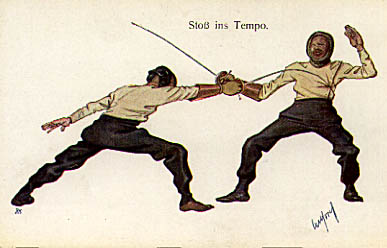Introduction to Fencing 110

Broken Tempo
What is Broken Tempo?
In fencing, during a bout, the fencers are engaged in a dance going back and forth on the strip. They do this trying to gain advantage and eventually score a touch. Just like a regular dance, there is a tempo that prevails during a bout. It may vary from bout to bout and from fencer to fencer depending on the tactics being used. The tempo can be fast or slow but it usually proceeds in a fixed pattern.
Broken Tempo is an advanced fencing technique where one fencer will change the “tempo” in mid-stream of an attack such that it throws his or her opponent off. This is a subtle move that is hard to perfect.
Let me describe a simple compound attack that one fencer will use against another. A is the attacker and B is the defender. A will initiate an attack with a beat and a lunge, the defender B will step back and parry and go for a riposte. Then A, will parry the riposte and re-double to score the touch. This is all happening in a split second on an even pace or tempo.
This is a very common scenario and especially in foil fencing when many exchanges can take place before one-person scores.
What happens when broken tempo is introduced? Fencer A in the final parry will hold the parry ever so slightly and slow the tempo down to almost a stop and then continue with a fast attack to score.
An analogy can be made in the game of tennis. Often during a match, two players will get into a back and forth volley crosscourt. Each will send the ball back to the other diagonally to keep the opponent in the quadrant. This may go on for many volleys at the same pace. At some point, one player will suddenly change the attack and send the ball down the line usually with a much faster attack thereby catching the other off guard.
The same is happening here. The tempo is suddenly changed by one fencer to catch the opponent off guard. Of course, it has to be executed with precision.
In sabre fencing, this is particular effective when instead of a point thrust, the action is done with a cut of the blade. For example, assume the same A and B fencer above. Fencer A make a beat and cut to the head, fencer B steps back and parry it and riposte to the flank, fencer A parry the riposte and go for the head cut but instead pause, as fencer B goes to parry, fencer A changes the cut from head to chest and finish the touch.
Summary
Fencing is a difficult sport to master. You cannot learn all the subtleties by reading a blog. What I am describing here is some advanced strategies that only a fencing master, after many lessons, will share with his student. I was lucky enough to have had two great coaches in my early career. First at CCNY was coach Lucia. He was selected as a backup coach in the 1964 Olympics, quite an honor. My second coach was meister Neiderkirshner at the NY Turn Verien.
© 2017 Jack Lee


